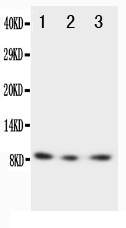
Anti-CX3CL1 antibody, PA1400, Western blotting Lane 1: Recombinant Human Fractalkine Protein 10ng Lane 2: Recombinant Human Fractalkine Protein 5ng Lane 3: Recombinant Human Fractalkine Protein 2.5ng
Anti-Fractalkine CX3CL1 Antibody Picoband(r)

PA1400
ApplicationsWestern Blot
Product group Antibodies
ReactivityHuman
TargetCX3CL1
Overview
- SupplierBoster Bio
- Product NameAnti-Fractalkine/CX3CL1 Antibody
- Delivery Days Customer9
- Antibody SpecificityNo cross reactivity with other proteins.
- Application Supplier NoteTested Species: In-house tested species with positive results. Predicted Species: Species predicted to be fit for the product based on sequence similarities. Other applications have not been tested. Optimal dilutions should be determined by end users.
- ApplicationsWestern Blot
- Applications SupplierWB
- CertificationResearch Use Only
- ClonalityPolyclonal
- Concentration500 ug/ml
- FormulationLyophilized
- Gene ID6376
- Target nameCX3CL1
- Target descriptionC-X3-C motif chemokine ligand 1
- Target synonymsABCD-3; C3Xkine; chemokine (C-X3-C motif) ligand 1; CX3C membrane-anchored chemokine; C-X3-C motif chemokine 1; CXC3; CXC3C; fractalkine; neurotactin; NTN; NTT; SCYD1; small inducible cytokine subfamily D (Cys-X3-Cys), member 1 (fractalkine, neurotactin); small inducible cytokine subfamily D (Cys-X3-Cys), member-1; small-inducible cytokine D1
- HostRabbit
- IsotypeIgG
- Protein IDP78423
- Protein NameFractalkine
- Scientific DescriptionBoster Bio Anti-Fractalkine CX3CL1 Antibody catalog # PA1400. Tested in WB applications. This antibody reacts with Human. The brand Picoband indicates this is a premium antibody that guarantees superior quality, high affinity, and strong signals with minimal background in Western blot applications. Only our best-performing antibodies are designated as Picoband, ensuring unmatched performance.
- ReactivityHuman
- Reactivity SupplierHuman
- Storage Instruction-20°C,2°C to 8°C
- UNSPSC12352203
References
- A new class of membrane-bound chemokine with a CX3C motif. Bazan JF et al., 1997 Feb 13, NatureRead more
